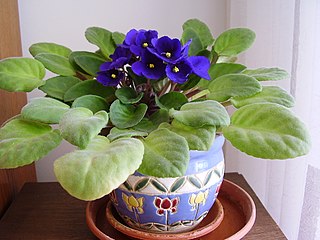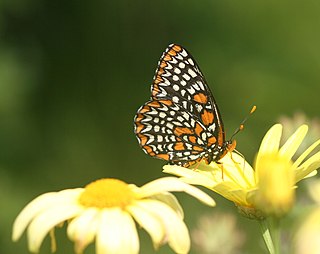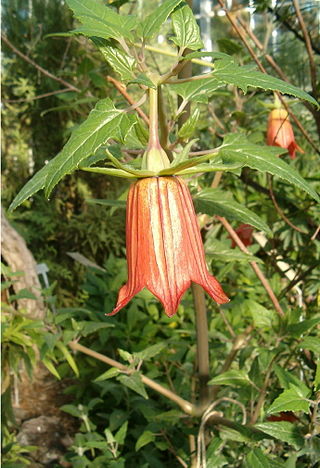
Apiaceae or Umbelliferae is a family of mostly aromatic flowering plants named after the type genus Apium, and commonly known as the celery, carrot or parsley family, or simply as umbellifers. It is the 16th-largest family of flowering plants, with more than 3,800 species in about 446 genera, including such well-known, and economically important plants as ajwain, angelica, anise, asafoetida, caraway, carrot, celery, chervil, coriander, cumin, dill, fennel, lovage, cow parsley, parsley, parsnip and sea holly, as well as silphium, a plant whose exact identity is unclear and may be extinct.

Digitalis is a genus of about 20 species of herbaceous perennial plants, shrubs, and biennials, commonly called foxgloves.

Pollination is the transfer of pollen from an anther of a plant to the stigma of a plant, later enabling fertilisation and the production of seeds. Pollinating agents can be animals such as insects, for example beetles or butterflies; birds, and bats; water; wind; and even plants themselves. Pollinating animals travel from plant to plant carrying pollen on their bodies in a vital interaction that allows the transfer of genetic material critical to the reproductive system of most flowering plants. When self-pollination occurs within a closed flower. Pollination often occurs within a species. When pollination occurs between species, it can produce hybrid offspring in nature and in plant breeding work.

Arbutus is a genus of 12 accepted species of flowering plants in the family Ericaceae, native to temperate regions of the Mediterranean, western Europe, the Canary Islands and North America, and commonly called madrones or strawberry trees. The name Arbutus was taken by taxonomists from Latin, where it referred to the species now designated Arbutus unedo.

Gesneriaceae, the gesneriad family, is a family of flowering plants consisting of about 152 genera and ca. 3,540 species in the tropics and subtropics of the Old World and the New World, with a very small number extending to temperate areas. Many species have colorful and showy flowers and are cultivated as ornamental plants.

Floral symmetry describes whether, and how, a flower, in particular its perianth, can be divided into two or more identical or mirror-image parts.

Victoria amazonica is a species of flowering plant, the second largest in the water lily family Nymphaeaceae. It is called Vitória-Régia or Iaupê-Jaçanã in Brazil and Atun Sisac in Inca (Quechua). Its native region is tropical South America, specifically Guyana and the Amazon Basin.

Digitalis purpurea, the foxglove or common foxglove, is a toxic species of flowering plant in the plantain family Plantaginaceae, native to and widespread throughout most of temperate Europe. It has also naturalized in parts of North America, as well as some other temperate regions. The plant is a popular garden subject, with many cultivars available. It is the original source of the heart medicine digoxin. This biennial plant grows as a rosette of leaves in the first year after sowing, before flowering and then dying in the second year. It generally produces enough seeds so that new plants will continue to grow in a garden setting.

Lotus berthelotii is a flowering plant endemic to the Canary Islands of Spain, in the genus Lotus of the pea family Fabaceae. Among its common names are lotus vine flower, parrot beak, pelican beak, and coral gem. This plant is widely cultivated but is either extinct in the wild or persists as a few individuals. In 1884 it was already classed as "exceedingly rare" and plant collection probably hastened its decline.

Zoophily, or zoogamy, is a form of pollination whereby pollen is transferred by animals, usually by invertebrates but in some cases vertebrates, particularly birds and bats, but also by other animals. Zoophilous species frequently have evolved mechanisms to make themselves more appealing to the particular type of pollinator, e.g. brightly colored or scented flowers, nectar, and appealing shapes and patterns. These plant-animal relationships are often mutually beneficial because of the food source provided in exchange for pollination.

Pedicularis is a genus of perennial green root parasite plants currently placed in the family Orobanchaceae.

Sinningia is a genus of flowering plants in the family Gesneriaceae. It is named after Wilhelm Sinning (1792–1874), a gardener of the Botanische Gärten der Friedrich-Wilhelms-Universität Bonn. There are about 65 species of tuberous herbaceous perennials, all occurring in Central and South America, with the greatest concentration of species occurring in southern Brazil.

Canarina is a genus of flowering plants within the family Campanulaceae. They are herbaceous perennial vines with bell-shaped flowers. The best known species is Canarina canariensis from the laurel forests of the Canary Islands which is grown as an ornamental plant. C. canariensis is one of a group of unrelated Canarian plants that appear to be adapted for bird pollination, including the members of the genera Isoplexis and Lotus. It was once thought that the original pollinators of these plants were sunbirds which had become extinct on the Canary Islands, explaining why some of these species are rare and considered endangered. However more recent work has shown that these plants are adequately pollinated by non-specialist flower visiting birds, particularly the Canary Islands chiffchaff and the Canary Island spectacled warbler, and in fact show some specific adaptations to infrequent pollination by these birds, such as extended flower lifespans, and a hexose-dominated sugar ratio of the nectar.

Pollination syndromes are suites of flower traits that have evolved in response to natural selection imposed by different pollen vectors, which can be abiotic or biotic, such as birds, bees, flies, and so forth through a process called pollinator-mediated selection. These traits include flower shape, size, colour, odour, reward type and amount, nectar composition, timing of flowering, etc. For example, tubular red flowers with copious nectar often attract birds; foul smelling flowers attract carrion flies or beetles, etc.

Berberis fortunei is a species of shrub in the family Berberidaceae, the barberry family, described in 1846. It is endemic to China, found in the provinces of Chongqing, Guangxi, Guizhou, Hubei, Hunan, Jiangxi, Sichuan, Taiwan, and Zhejiang. It is grown as an ornamental in many lands, with common names including Chinese mahonia, Fortune's mahonia, and holly grape.

Canarina canariensis is a species of flowering plant in the bellflower family Campanulaceae, commonly known as the Canary Island bellflower, and known locally as bicácaro.

Digitalis davisiana is a species of foxglove, a herbaceous plant in the genus Digitalis in the family Plantaginaceae, formerly in the Scrophulariaceae and briefly the Veronicaceae. It is native to Turkey.

Digitalis canariensis is a member of the genus Digitalis.

Digitalis chalcantha is a flowering evergreen shrub in the family Plantaginaceae. It is native to the Canary Islands, specifically Gran Canaria.

Digitalis isabelliana, known commonly as Isabel's foxglove, Canary Island foxglove, or Gran Canaria Pineforest foxglove, is a type of flowering shrub, one of three types of foxglove species native to the Canary Islands.






















